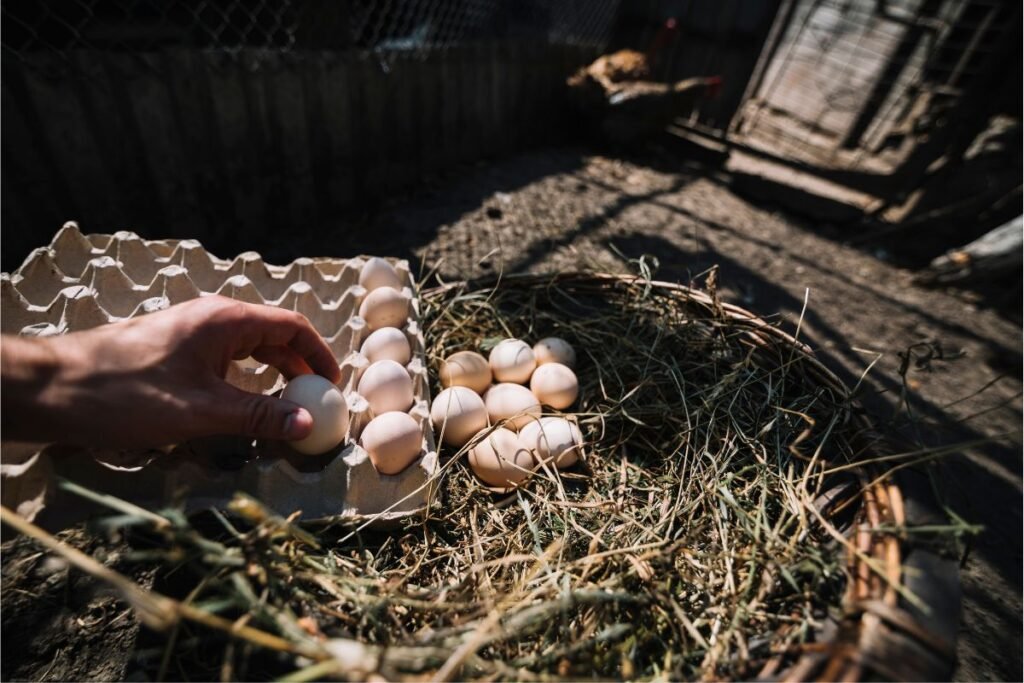Cage eggs come from hens housed in battery cage systems, which have been the dominant form of commercial egg production for decades. Understanding this system is essential for anyone entering the egg farming business.
In conventional cage systems, laying hens are housed in rows of cages stacked in climate-controlled barns. Each cage typically houses multiple birds, providing them with continuous access to food and water through automated feeding systems.
The cage structure includes sloped floors that allow eggs to roll gently onto collection belts. This design minimizes egg breakage and keeps eggs clean by separating them from the hens immediately after they lay.
Modern cage facilities use sophisticated climate control systems to maintain optimal temperatures year-round. This controlled environment protects hens from extreme weather conditions and helps maintain consistent egg production.
Automated feeding systems deliver precisely measured portions of nutritionally balanced feed to each cage. This ensures every hen receives adequate nutrition without waste or competition for food.
Waste management in cage systems is highly efficient. Manure drops through the cage floors onto collection belts or into pits below, keeping the living area clean and making waste removal more manageable.
The production cycle in cage systems is carefully monitored. Eggs are collected multiple times daily via automated belt systems, reducing handling and maintaining freshness from the hen to the collection point.
Lighting programs in cage facilities are precisely controlled to optimize laying patterns. Hens receive specific light-dark cycles that encourage consistent egg production throughout the year.

The Advantages and Disadvantages of Cage Eggs
Every egg production system comes with its own set of benefits and challenges. Understanding both sides helps you make informed decisions for your farming operation.
Cage systems offer remarkable efficiency in terms of space utilization. A single barn can house tens of thousands of hens in a relatively compact footprint, making it economically viable for commercial operations.
Disease management becomes more straightforward in cage systems because birds have limited contact with their own waste. The separation between hens and manure significantly reduces the risk of disease transmission.
Feed efficiency in cage systems tends to be higher because hens expend less energy on movement. This translates to better feed conversion ratios, meaning more eggs produced per unit of feed consumed.
Labor costs are generally lower in cage operations due to high levels of automation. Feeding, watering, egg collection, and waste removal can all be mechanized, reducing the need for manual labor.
However, cage systems face significant criticism regarding animal welfare. Hens in conventional cages have limited space for natural behaviors like wing spreading, dust bathing, or nesting.
The restricted movement in cages can lead to health issues, including weakened bones and muscle deterioration. These concerns have prompted many regions to implement stricter welfare standards.
Consumer perception has shifted dramatically in recent years. Many shoppers now actively seek out cage-free or free-range eggs, viewing them as more ethical and humane options.
Regulatory pressures continue to mount globally. Numerous countries and regions have already banned or are phasing out conventional battery cages in favor of enriched cages or cage-free systems.
Are Cage Eggs Less Nutritious?
One of the most common questions about cage eggs concerns their nutritional value compared to eggs from other production systems. The scientific evidence provides clear answers.
Multiple peer-reviewed studies have examined the nutritional content of eggs from different housing systems. The overwhelming consensus shows that housing type has minimal impact on basic nutritional composition.
Eggs from cage systems contain the same high-quality protein, vitamins, and minerals as those from cage-free or free-range systems. A large egg provides approximately six grams of protein regardless of how the hen was housed.
The primary nutritional differences that do exist relate to the hen’s diet rather than her housing. Hens fed omega-3-enriched diets will produce eggs with higher omega-3 content, whether they live in cages or not.
Vitamin D content in eggs can vary based on the hen’s exposure to UV light or dietary supplementation. However, this is managed through feed formulation rather than housing type.
Some studies have found minor variations in vitamin E and omega-3 fatty acids between eggs from different systems. These differences are typically attributed to differences in feed composition and access to diverse food sources.
The yolk color in eggs can vary significantly based on diet. Hens with access to grass and insects often produce darker yolks, but this is purely cosmetic and doesn’t indicate superior nutrition.
Shell strength and quality remain consistent across housing systems when hens receive proper calcium and vitamin D3 supplementation. Housing type doesn’t compromise the protective quality of the eggshell.
From a food safety perspective, proper handling and storage matter far more than production method. All eggs, regardless of source, should be refrigerated and cooked thoroughly to minimize any food safety risks.

What Are Cage Eggs?
Cage eggs represent the product of conventional battery cage farming, a system that has shaped commercial egg production for over half a century. Understanding what defines cage eggs helps consumers and farmers make informed choices.
The term cage eggs specifically refers to eggs produced by hens living in conventional battery cages. These are wire enclosures that typically house four to eight hens per cage in commercial operations.
Each hen in a conventional cage has approximately 430 to 560 square centimeters of space, roughly equivalent to a standard sheet of letter-sized paper. This space allocation has been a major point of contention in animal welfare discussions.
Cage eggs are collected through automated systems that gather eggs multiple times per day. This frequent collection ensures eggs remain fresh and reduces the risk of damage or contamination.
The standardization in cage systems means cage eggs often have a very consistent size, shape, and quality. This uniformity appeals to commercial buyers and food service operations requiring predictable products.
Cage eggs can be produced in both conventional cages and enriched or furnished cages. Enriched cages provide additional space and enrichments like perches and nesting areas, representing a middle ground between conventional cages and cage-free systems.
The identification of cage eggs varies by region. In some areas, eggs must be clearly labeled with their production method, while in other regions, have less stringent labeling requirements.
Price positioning of cage eggs typically makes them the most affordable option at retail. The production efficiencies of cage systems translate to lower costs for consumers.
What Are Some Advantages or Disadvantages of Cage Egg Farming?
Advantages
For farmers considering different production methods, cage systems offer several practical advantages that have sustained their popularity in commercial operations worldwide.
Biosecurity in cage operations is significantly easier to maintain. The controlled environment and limited access points help prevent the introduction and spread of diseases that can devastate poultry populations.
Predator protection is inherent in cage systems. The enclosed barn environment shields hens from foxes, hawks, raccoons, and other predators that pose constant threats to outdoor or free-range operations.
Environmental control capabilities allow farmers to maintain optimal conditions year-round. Temperature, humidity, and ventilation can be precisely managed to support hen health and productivity.
Egg quality consistency tends to be higher in cage systems. The clean, controlled environment minimizes contamination risks and ensures eggs meet strict quality standards.
Resource efficiency extends beyond just feed. Water usage can be carefully controlled and monitored in cage systems, reducing waste and ensuring each hen receives adequate hydration.
Data collection and flock monitoring are simplified in cage operations. Modern systems can track production metrics for specific cage rows or even individual cages, enabling precise management decisions.
Medication and vaccination programs are easier to implement in cage systems. When treatment is necessary, reaching every bird and ensuring proper dosage administration is more straightforward.
Startup costs for cage operations can be lower than cage-free systems on a per-bird basis. The efficient use of space means you can house more birds in the same barn footprint.
The proven track record of cage systems provides farmers with established best practices and reliable production data. This reduces uncertainty when planning and managing operations.
Disadvantages
While cage systems offer practical advantages, they also present significant challenges that farmers must carefully consider before investing in this production method.
Animal welfare concerns top the list of disadvantages. Hens in conventional cages cannot express many natural behaviors, leading to welfare advocates strongly opposing this production method.
The inability to dust bathe, a natural behavior crucial for hen comfort and feather maintenance, represents a significant welfare compromise. Dust bathing helps hens clean their feathers and maintain healthy skin.
Limited exercise opportunities in cages can lead to weakened bones and reduced muscle mass. Hens housed in cages for extended periods may develop osteoporosis and increased susceptibility to bone fractures.
Feather pecking and cannibalism can occur in cage systems, particularly when hens are stressed or overcrowded. These behaviors can spread through a facility and cause significant welfare issues and production losses.
Market access is increasingly restricted for cage eggs. Major retailers, restaurants, and food manufacturers have committed to sourcing only cage-free eggs, limiting sales opportunities for cage egg producers.
Consumer preference has shifted dramatically toward cage-free and free-range eggs. Younger consumers especially show strong preferences for eggs from alternative housing systems, even at higher prices.
Regulatory uncertainty poses business risks. Governments worldwide are implementing or considering cage bans, potentially requiring expensive retrofits or complete system overhauls.
Initial capital investment for modern cage systems remains substantial. While per-bird costs may be lower, the total investment for an automated cage facility represents a significant financial commitment.
Social license to operate is increasingly challenged. Community opposition to cage operations can complicate expansion plans and create conflicts with neighbors and local governments.
Worker satisfaction may be lower in cage operations. Some farm workers find the repetitive nature and welfare concerns of cage systems less fulfilling than working with cage-free or pasture-based systems.
What Are Barn-Laid Eggs?

Understanding barn-laid eggs provides important context for comparing different egg production systems. This method represents a significant departure from cage-based production.
Barn-laid eggs, also called cage-free eggs, come from hens living in open barns without cages. These hens can move freely throughout the barn space, expressing natural behaviors like walking, wing flapping, and dust bathing.
The space allocation in barn systems typically provides more room per bird than conventional cages. Birds have access to perches, nesting boxes, and scratching areas that support natural behaviors.
Nesting boxes in barn systems give hens private spaces to lay eggs. This addresses a fundamental behavioral need and can reduce stress during the laying process.
Perching opportunities are crucial in barn systems. Hens naturally roost at night, and elevated perches allow them to express this instinctive behavior while also providing additional usable space.
Litter or bedding material covers the barn floor, allowing hens to scratch and dust bathe. This material requires regular management to maintain cleanliness and control ammonia levels.
Egg collection in barn systems can be automated if nest boxes are designed appropriately, though it typically requires more labor than cage systems. Eggs laid outside nest boxes must be collected manually.
The social structure in barn systems more closely resembles natural chicken behavior. Hens can establish pecking orders and social hierarchies within manageable group sizes.
Ventilation becomes more critical in barn systems. The higher bird density at floor level and decomposing litter create air quality challenges that must be carefully managed.
The Importance of Eliminating Cages
The movement toward cage-free egg production reflects growing recognition of animal welfare as a fundamental business consideration. Understanding this trend helps farmers plan for the future.
Scientific research on hen welfare has consistently demonstrated that hens in enriched environments exhibit less stress and more natural behaviors. Studies measuring stress hormones show lower levels in cage-free systems.
Consumer demand drives much of the transition away from cages. Surveys consistently show that when educated about production methods, most consumers prefer eggs from cage-free or free-range systems.
Corporate commitments have accelerated the cage-free transition. Hundreds of major food companies have pledged to source only cage-free eggs, creating market pressure that influences production decisions.
The economic case for cage-free production strengthens as more producers transition. The premium prices for cage-free eggs help offset higher production costs, making the business case more favorable.
Worker welfare considerations also support the move away from cages. Many farm workers report greater job satisfaction when working with cage-free systems that prioritize animal welfare.
Environmental considerations add another dimension to the cage debate. Properly managed cage-free systems can integrate manure management with crop production more easily than concentrated cage operations.
International precedent continues to build. The European Union banned conventional battery cages in 2012, and numerous countries have followed or announced similar policies.
Innovation in cage-free housing continues to evolve. New barn designs, management technologies, and genetic improvements make cage-free production increasingly efficient and practical.
The long-term sustainability of egg farming increasingly depends on meeting consumer expectations for animal welfare. Farms that transition proactively position themselves better than those forced to change by regulation.
Planning Your Egg Farming Business
Starting an egg farming operation requires careful planning and consideration of multiple factors. Your success depends on making informed decisions about production methods, market access, and business structure.
Market research should be your first step. Understand local demand for different egg types, identify potential buyers, and assess competition in your area. This information guides your production system choice.
Capital requirements vary dramatically between production methods. Cage systems require significant upfront investment in specialized equipment, while cage-free barns may have lower initial costs but higher ongoing labor expenses.
Location selection influences your operation in multiple ways. Proximity to feed suppliers, processing facilities, and markets affects transportation costs and product freshness. Local regulations may also restrict or favor certain production methods.
Flock size decisions should balance your resources, market demand, and management capacity. Starting smaller allows you to learn systems and build experience before scaling up.
Feed sourcing represents your largest ongoing expense. Establishing reliable relationships with quality feed suppliers ensures consistent nutrition for your flock and stable input costs.
Biosecurity planning prevents disease outbreaks that could devastate your operation. Implement protocols for visitor management, equipment sanitation, and flock health monitoring from day one.
Marketing strategies differentiate your eggs in the marketplace. Consider certifications, direct-to-consumer sales, or partnerships with local retailers to build a customer base willing to pay premium prices.
Financial projections should account for realistic production levels, mortality rates, and market prices. Build contingency plans for unexpected expenses or market fluctuations.
Mentorship from experienced egg farmers provides invaluable insights. Join industry associations, attend conferences, and build relationships with successful producers in your region.
The Future of Egg Farming
The egg industry continues evolving rapidly as consumer preferences, regulations, and production technologies advance. Understanding these trends helps you build a future-proof operation.
Cage-free production will dominate in many markets within the next decade. Early adopters of cage-free systems position themselves advantageously as market demand shifts and regulations tighten.
Technology integration improves efficiency across all production systems. Automated monitoring, data analytics, and precision feeding systems help farmers optimize production while reducing labor requirements.
Sustainability considerations increasingly influence consumer choices. Farms demonstrating environmental stewardship through renewable energy, water conservation, and responsible waste management gain competitive advantages.
Transparency in production methods becomes ever more important. Consumers want to know how their food is produced, creating opportunities for farms that embrace open communication and education.
Alternative protein sources may impact egg demand long-term, but eggs remain nutritionally unique and culturally significant. Innovation in egg products and applications continues creating new market opportunities.
The successful egg farming operation of the future balances animal welfare, environmental sustainability, economic viability, and food safety. Farms that excel across all these dimensions will thrive in the evolving marketplace.
Starting an egg farming business offers real opportunities for dedicated individuals willing to learn and adapt. Whether you choose cage, cage-free, or free-range production, success requires commitment to excellence in animal care, business management, and continuous improvement.
Your journey in egg farming begins with education and careful planning. Use the insights from this guide to inform your decisions, seek mentorship from experienced producers, and stay current with industry developments. With dedication and proper management, your egg farming operation can provide both financial rewards and the satisfaction of producing nutritious food for your community.
Eggborne Salmonella
Food safety remains paramount in egg production regardless of housing system. Understanding Salmonella risks and prevention helps ensure safe, high-quality eggs reach consumers.
Salmonella enteritidis represents the primary food safety concern in egg production. This bacteria can infect hen ovaries and contaminate eggs before shells form, making it particularly challenging to control.
The prevalence of Salmonella varies across production systems and regions. Proper biosecurity, vaccination programs, and flock health management matter far more than housing type in controlling this pathogen.
Vaccination against Salmonella has proven highly effective in reducing infection rates. Many commercial operations now vaccinate their flocks as a standard practice, significantly improving egg safety.
Feed contamination historically served as a major Salmonella source. Modern feed mills implement strict quality controls and heat treatment to eliminate pathogens from feed ingredients.
Rodent control plays a crucial role in Salmonella prevention. Mice and rats can carry and spread the bacteria throughout poultry facilities, making pest management essential.
Environmental monitoring helps detect Salmonella presence before it causes widespread problems. Regular testing of barn environments, equipment, and birds allows early intervention.
Egg handling procedures significantly impact food safety. Proper collection, cleaning, and refrigeration are essential regardless of production system. Maintaining the cold chain from farm to consumer minimizes bacterial growth.
Consumer education remains vital. Proper cooking eliminates Salmonella risk, and safe handling practices at home prevent cross-contamination with other foods.
The shell quality contributes to food safety. Strong, intact shells provide a natural barrier against bacterial penetration. Ensuring hens receive adequate calcium supports shell integrity.
Regulatory oversight of egg production includes mandatory testing and control programs in many regions. These systems help identify and address Salmonella problems quickly, protecting public health.
